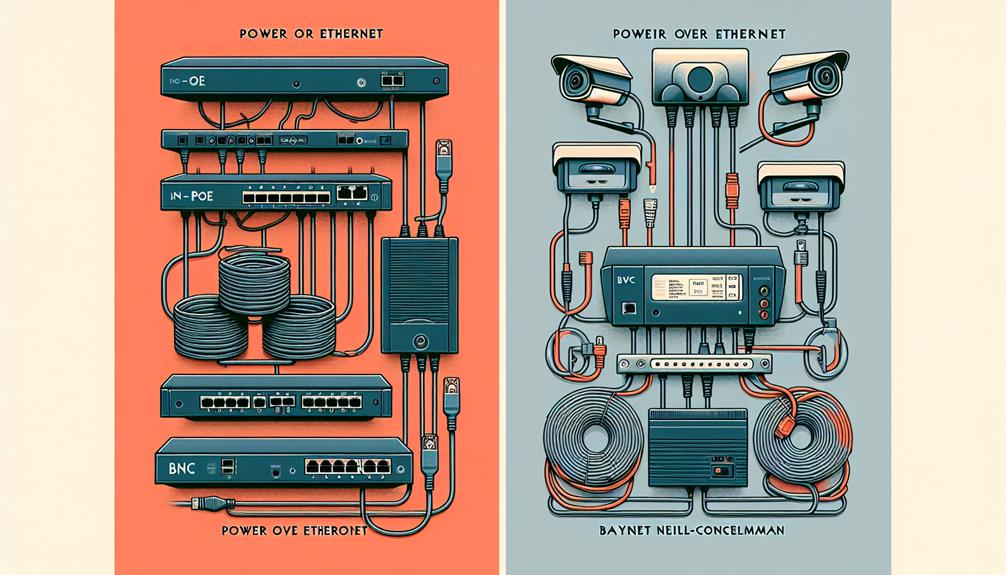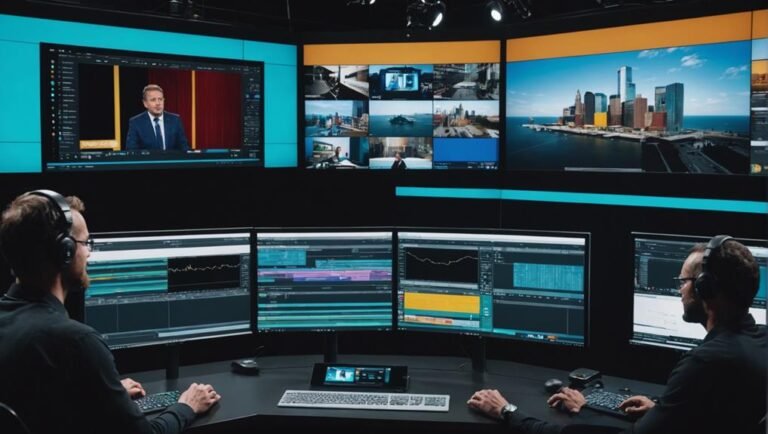When deciding between CCTV PoE and BNC systems, it depends on your priorities. PoE uses a single Ethernet cable for power and data, simplifying installation and offering superior image quality and easier scalability. BNC is reliable for stable analog connections but involves separate cables for power, potentially complicating setup and increasing maintenance costs. PoE is more cost-effective in the long run despite higher initial costs, while BNC might appear cheaper upfront. If you want to learn the full picture, including cost details and distance limitations, there’s more to uncover.
Overview of PoE
Power over Ethernet (PoE) simplifies your CCTV setup by transmitting power and data through a single Ethernet cable. Imagine the freedom of not needing separate power lines for each camera. With PoE, you’re cutting down on clutter and complexity, making your security system much easier to manage.
A big advantage of PoE is its ease of installation. You don’t need an electrician to run power lines, which can save you both time and money. Just plug the Ethernet cable into a PoE switch or injector, and you’re good to go. Plus, the ability to transmit data and power over a single cable allows for greater flexibility in camera placement. Want to move a camera to a different location? No problem, just shift the Ethernet cable.
PoE is also highly scalable. Whether you’re starting with a small system or planning to expand, PoE can grow with you. You can add more cameras without worrying about additional power sources. And since it’s based on standardized technology, compatibility issues are minimal. Ultimately, PoE offers a straightforward, efficient way to enhance your security setup while giving you the freedom to adapt and expand as needed.
Overview of BNC
While PoE offers a modern solution for CCTV systems, traditional BNC connections still hold significant value in the world of security surveillance. BNC, or Bayonet Neill-Concelman, connectors have been around for decades and are known for their reliability and robustness. If you’re looking for a tried-and-true method, BNC might just be what you need.
BNC connectors are primarily used with analog cameras, transmitting video signals over coaxial cables. This method provides a stable and interference-free connection, ensuring that your footage remains clear and uninterrupted. Plus, BNC connections support longer cable runs without significant signal loss, making them ideal for larger properties or installations requiring extensive coverage.
One of the main advantages of BNC is its simplicity. You don’t need to worry about network configurations or IP addresses. Just plug in the cables, and you’re good to go. This ease of use is perfect for those who prefer straightforward setups without the complexity of modern networking.
With BNC, you get a reliable, easy-to-install solution that stands the test of time. If you’re someone who values freedom from complicated setups, BNC offers a solid choice for your surveillance needs.
Installation Process
Setting up a CCTV system with either PoE or BNC connections involves a straightforward yet distinct set of steps for each method. If you’re opting for PoE, your path is paved with simplicity. Connect your PoE camera to a PoE switch using an Ethernet cable. This single cable will handle both power and data, sparing you from extra wiring. After that, link the PoE switch to your network router, and you’re practically done. The camera should come online quickly, and you can manage it through your network’s software.
On the other hand, installing a BNC-based system is a bit more hands-on. You’ll need to connect each camera to the DVR using separate coaxial cables for video and power cables for electricity. While this means more cables to manage, it also offers a robust, dedicated connection. Once all cameras are wired to the DVR, connect the DVR to your monitor and power it up. You’ll then configure the settings directly on the DVR or via its software.
Both methods have their own perks, but PoE’s streamlined installation process makes it a go-to for those craving a hassle-free setup.
Cost Comparison
When comparing costs, you’ll find that PoE systems often have a higher initial price tag but can save you money on installation and maintenance over time. PoE (Power over Ethernet) cameras use a single cable for both power and data, simplifying the installation process. This can notably reduce labor costs and the number of cables you need. On the other hand, BNC (Bayonet Neill-Concelman) systems might seem cheaper upfront since the cameras and DVR units tend to be less expensive.
Let’s break down the cost comparison:
| Cost Aspect | PoE Systems | BNC Systems |
|---|---|---|
| Initial Equipment Cost | Higher | Lower |
| Installation Labor Cost | Lower (Single Cable) | Higher (Separate Cables) |
| Maintenance Costs | Lower (Simplified) | Higher (More Components) |
Choosing PoE could give you more freedom regarding scalability and future upgrades. With fewer cables to manage, maintenance becomes easier, saving you both time and money. While the upfront cost for PoE might be higher, the long-term savings could outweigh the initial investment. So, if you’re looking for a system that’s easier to install and maintain, PoE is the way to go.
Image Quality
PoE systems often deliver superior image quality thanks to their ability to support higher resolutions and advanced features. You’ll notice the difference right away, as these systems can handle HD and even 4K video, capturing every detail with clarity. This means you can identify faces, license plates, and other essential details without any hassle.
In contrast, traditional BNC systems typically max out at lower resolutions. While they can still provide a clear image, they often can’t compete with the sharpness and detail that PoE systems offer. Plus, PoE cameras often come with advanced features like WDR (Wide Dynamic Range) and low-light capabilities, ensuring you get the best image quality in various lighting conditions.
Another advantage of PoE systems is their digital nature, which minimizes interference and signal loss. This results in a more consistent and reliable image quality, giving you peace of mind. On the other hand, BNC systems are analog and more prone to interference, leading to potential image degradation.
Distance Limitations
While PoE systems excel in image quality, they also offer significant advantages when it comes to distance limitations. With PoE (Power over Ethernet), you can run a single Ethernet cable up to 100 meters (328 feet) without signal loss. This kind of flexibility allows you to place cameras exactly where you need them, giving you the freedom to secure your property without worrying about signal degradation.
On the other hand, BNC (Bayonet Neill-Concelman) systems, which use coaxial cables, face more stringent distance limitations. Typically, BNC connections start to lose signal quality after 90 meters (295 feet). To extend beyond this, you’d need signal boosters or additional equipment, which can complicate your setup and restrict your freedom to place cameras wherever you want.
Moreover, PoE technology supports easy integration with network infrastructure, making it simpler to manage and extend your security system. BNC systems, constrained by their distance limitations and additional hardware requirements, can quickly become cumbersome if you need to cover larger areas.
Choosing PoE over BNC means fewer hurdles and more freedom in designing a surveillance system that meets your specific needs. Say goodbye to distance worries, and focus on what truly matters—keeping your space secure.
Power Requirements
One major advantage of using PoE systems is that they simplify power requirements by delivering both data and power through a single Ethernet cable. This convenience means you don’t have to worry about running separate power lines, giving you more freedom to place your cameras wherever you need them.
With PoE, you can enjoy:
- Streamlined installation: Cut down on the mess and hassle of multiple cables.
- Flexibility in placement: Position your cameras in the most strategic locations without worrying about nearby power sources.
- Cost efficiency: Save on labor and materials by reducing the number of cables needed.
- Safety and reliability: Minimize the risk of electrical hazards and potential points of failure.
- Scalability: Easily expand your system without significant rewiring (more on this in the next section).
On the other hand, traditional BNC systems require separate power cables for each camera, complicating the setup and limiting your flexibility. You’ll need to make sure there’s a power outlet near each camera or run extra wiring, which can be both time-consuming and restrictive.
Choosing PoE over BNC can be a game-changer for your CCTV setup, offering you the freedom to create a more efficient, flexible, and reliable security system.
Scalability
Expanding your CCTV system becomes much simpler and more efficient with PoE due to its inherent scalability. With PoE, you can add new cameras effortlessly without worrying about additional power sources. Each camera gets both power and data through a single Ethernet cable, making the process streamlined. You’re not limited by proximity to power outlets or tangled wires, giving you the freedom to place cameras wherever they’re needed.
In contrast, BNC systems require separate coaxial cables for video and power, complicating the expansion process. You’d need to make sure there’s a power supply close to each new camera, adding to the installation time and cost. Plus, managing multiple cables can quickly become a logistical nightmare.
PoE switches also make it easy to integrate new cameras into your network. Just plug the camera into the switch, and it’s ready to go. You can monitor and manage everything from a central location, making scaling up a breeze. BNC systems, however, often require additional hardware like splitters and amplifiers, which can clutter your setup and restrict your flexibility.
For a hassle-free, scalable CCTV solution that grants you the freedom to expand as needed, PoE is the clear winner.
System Compatibility
How well do PoE and BNC systems integrate with your existing CCTV setup? Let’s break it down so you can make an informed choice that fits your needs.
PoE (Power over Ethernet) systems are modern and versatile. They use a single cable for both power and data, simplifying installation and reducing clutter. If your infrastructure already has Ethernet cabling, integrating PoE cameras is straightforward and hassle-free. Plus, PoE switches allow you to expand your network with ease.
On the other hand, BNC (Bayonet Neill–Concelman) systems, which use coaxial cables, are more traditional. If you’re upgrading an older analog system, BNC might be the way to go since it maintains compatibility with existing setups.
Here are some key points to take into account:
- PoE Systems: Simplify wiring with a single cable for power and data.
- BNC Systems: Offer seamless integration with older analog setups.
- PoE Switches: Expand your network effortlessly.
- Ethernet Cables: Already in place in many modern infrastructures.
- Coaxial Cables: Ideal for maintaining compatibility with older systems.
Choosing between PoE and BNC depends on your current setup and future needs. Evaluate both options to determine which one aligns with your desire for freedom and flexibility in your security system.
Frequently Asked Questions
Can Poe and BNC Systems Be Integrated Within the Same Security Network?
You can integrate PoE and BNC systems within the same security network. You’ll need adapters or hybrid DVRs to connect and manage both types. This setup gives you the flexibility to choose your preferred equipment.
Are There Any Specific Maintenance Requirements for Poe or BNC Systems?
You might think maintenance is a hassle, but it’s manageable. For PoE systems, make sure firmware updates and clean connections. BNC systems need cable inspections and possible replacements. You’ll maintain your freedom with minimal effort.
Do Poe Cameras Function During a Power Outage?
During a power outage, PoE cameras won’t function unless you have a backup power source like a UPS. If you want uninterrupted surveillance, make sure you’ve got a reliable backup in place.
How Do Environmental Conditions Affect Poe Vs. BNC Cameras?
When the weather gets wild, PoE cameras can still dance in the storm thanks to their single cable simplicity. BNC cameras, on the other hand, might trip over themselves with multiple cables prone to damage.
What Are the Cybersecurity Risks Associated With Poe Systems?
You should watch out for cybersecurity risks with PoE systems, like unauthorized access and data breaches. Hackers can exploit vulnerabilities in your network, so always update firmware and use strong passwords to protect your freedom and privacy.



